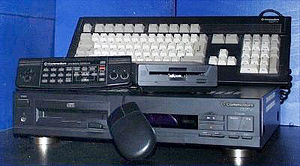CDTV
 |
|
 |
|
| Manufacturer | Commodore International |
|---|---|
| Type | Home multimedia entertainment / Home video game console / Personal computer |
| Generation | Fourth generation |
| Release date | March 1991 |
| Introductory price | US$999 (equivalent to $1,757 in 2016) |
| Media | CD-ROM |
| Operating system | AmigaOS 1.3 |
| CPU | Motorola 68000 @ 7 MHz |
| Memory | 1 MB |
| Predecessor | Commodore 64 Games System |
| Successor | Amiga_CD32 |
The CDTV (an acronym for "Commodore Dynamic Total Vision", a backronym of an acronym for "Compact Disc Television", giving it a double meaning) is a multimedia platform developed by Commodore International and launched in March 1991.
CDTV was essentially a Commodore Amiga 500 home computer with a CD-ROM drive and remote control. With the optional keyboard, mouse, and disk drive, it gained the functionality of the Amiga. Commodore marketed the machine as an all-in-one multimedia appliance in a stereo-like case rather than a computer. As such, it targeted the same market as the Philips CD-i. The expected market for multimedia appliances did not materialise, and neither machine met with any real commercial success. Though the CDTV was based entirely on Amiga hardware it was marketed strictly as a CDTV, with the Amiga name omitted from product branding.
Commodore announced the CDTV at the summer 1990 Consumer Electronics Show in Chicago, promising to release it before the end of the year with 100 software titles. The product debuted in North America in March 1991 (CES Las Vegas) and in the UK (World of Commodore 1991 at Earls Court, London). It was advertised at £499 for the CDTV unit, remote control and two software titles. The device was released in the United States for $999.
By 1990, Commodore had a poor reputation among consumers and developers. Computer Gaming World wrote that year of its "abysmal record of customer and technical support in the past". The company chose Amiga enthusiast magazines as its chief advertising channel, but the Amiga community on the whole avoided the CDTV in the expectation of an add-on CD-ROM drive for the Amiga, which eventually came in the form of the A570. This further hurt sales of the CDTV, as both it and an A570-equipped A500 were the same electronically, and could both run CDTV software, so there was very little motivation to buy it. Commodore would rectify this with CDTV's successor, the A1200-based Amiga CD32, by adding the Akiko chip. This would enable CD32 games to be playable only on the CD32. However, Nolan Bushnell, one of the chief endorsers of the CDTV, argued the system's high price point alone was enough to explain its market failure: "... it's very difficult to sell significant numbers of anything at more than $500. ... I felt that I could sell a hundred thousand of something that costs $800 standing on my head. I thought that it would be a no-brainer. And I can tell you that the number of units that we sold in the U.S. at $800 you could put in your eye and not draw tears."
...
Wikipedia
